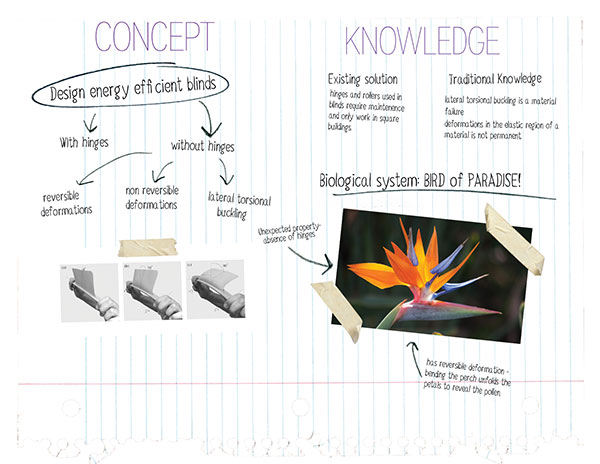How JMU professors are shaping the engineering curriculum
NewsSUMMARY: The National Science Foundation recognizes the importance of their work and provided a $128,000 grant to create and test the materials. The NSF also funded similar work at the University of Georgia by Dr. Ramana Pidaparti. Nagel and Pidaparti will be sharing their materials and assessing their effectiveness at each school.

Graphic by Wren Snyder ('17), JMU Communications
From Velcro to airplane wings to barbed wire, the natural world's influence on engineering solutions is ubiquitous, but materials and courses for teaching bio-inspired design are limited.
Dr. Jacquelyn Nagel, an assistant professor of engineering, and Dr. Chris Rose, a professor of biology, are trying to change that by creating instructional materials that can be used to teach bio-inspired design across a wide spectrum of engineering disciplines.
The National Science Foundation recognizes the importance of their work and provided a $128,000 grant to create and test the materials. The NSF also funded similar work at the University of Georgia by Dr. Ramana Pidaparti. Nagel and Pidaparti will be sharing their materials and assessing their effectiveness at each school.
"As engineers, we know that it’s really easy to get students excited about bio-inspired design. . . . The tricky part is teaching them how to do it." —Dr. Jacquelyn Nagel
"The grant is funding research related to development, implementation, assessment and dissemination of instructional resources that can help engineering faculty teach this topic of bio-inspired design," Nagel said.
Nagel and her colleagues are creating homework assignments, lectures, projects and learning activities to use in a variety of classes. By creating flexible materials, they can be used in engineering courses from circuits to thermal fluids to simulation and modeling.
"As engineers, we know that it’s really easy to get students excited about bio-inspired design," Nagel said. "Students think it’s really interesting and it draws them in. The tricky part is teaching them how to do it."
Since biology is such a large field, Nagel is getting students to hone in on specific aspects of nature in their work. Rose is assisting with all things biology related — choosing biological systems for the instructional materials, helping the engineering faculty to understand the connections between biology and engineering, creating the biological information for the instructional materials, helping to define novice/intermediate/expert level biological information in order to scaffold student learning, and helping to design a course that teaches bio-inspired design.
"What you’re trying to figure out is: What’s going on in nature that’s different from what we’re already doing?" she said. "We as individuals can’t know everything—we’re not computers—but there are libraries of information out there and we can seek out that information and start to make these connections."
In addition to creating materials that will get students thinking about bio-inspired solutions, Nagel said it is also important to test their effectiveness. "We’re always implementing and assessing to make sure we’re meeting the goals we set out to meet," she said. "We want to create materials that are evidence-based so we know they actually work."
Working with Dr. Cheri Beverly in the College of Education, Nagel came up with three questions to ask students who worked with the materials she created: What did you learn about the content? How did you learn that content? and, What are you going to do with that content?
"Topics that are crosscutting, interdisciplinary, involve systems thinking and involve connection building across a curriculum are the topics that can attract and retain women and underrepresented minorities." — Dr. Jacquelyn Nagel
So far, results have been positive. "They’re writing in their reflections that they’re impressed with what they’re learning about biology and they never realized that biology has solved problems similar to what engineers face," Nagel said.
Nagel's materials will be tested by mechanical engineering students at the University of Georgia this spring, where Pidaparti has proposed developing a deck of cards that will promote bio-inspired problem solving. His work could begin this summer, Nagel said.
In addition to providing students with additional knowledge about an important topic, teaching biomimicry also attracts women and underrepresented minority students to the STEM field.
"Topics that are crosscutting, interdisciplinary, involve systems thinking and involve connection building across a curriculum are the topics that can attract and retain women and underrepresented minorities," Nagel said. "Bio-inspired design is one example of that because it brings together biology, engineering, physics and math to explain what we’re seeing in nature and then connect that back to physical principles and other engineering principles to solve our problems."
The grant is assisting on a small scale at the moment, but Nagel said she and her colleagues have "big and grand ideas" for the future.
By Rachel Petty (’17), JMU Communications & Marketing

